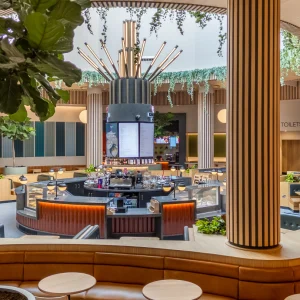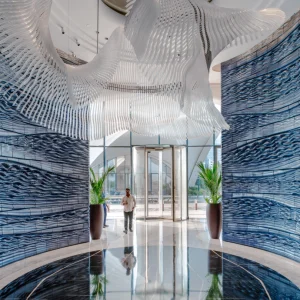THE NAME OF CAEN is inextricably linked to tripe, anemones and William the Conqueror. It means ‘battlefield’ in Celtic – however, on this ancient battlefield, history repeated itself with a devastating vengeance only 80 years ago. Caen suffered to save the Western world. In 1944, the battle for the city lasted two months. Threequarters of the buildings were knocked flat. At least 10,000 people died. The scars still show, but they have been turned to good effect. Today, Caen deserves time. There are hidden rewards. It would be easy to write an excoriation of some of the ersatz and egregious buildings that arose in the wake of the destructive bombing that shattered Caen’s medieval heart, so gruesome is some of the architecture. With hindsight, the bombing came to be regarded as one of the most futile air attacks of the war, accomplishing nothing but the levelling of a great Norman city. However, a new district, the Presqu’île de Caen, is focused on the future and boasts one of the finest libraries in France, the large Bibliothèque Alexis de Tocqueville designed by OMA, while part of the fine heart of the city was, remarkably, preserved and contains some gems.
 Inside the Église Saint-Nicolas in Caen. Image Credit: MBA.Caen/C.Schuhmann
Inside the Église Saint-Nicolas in Caen. Image Credit: MBA.Caen/C.Schuhmann
The Musée des Beaux-Arts and the Musée de Normandie are both tucked within the citadel that William the Conqueror held in 1060. Before the World War 2 bombardment Caen was the ‘cité de cent clochers’, the town of a hundred belfries. Few survive. During the bombing people slept, cooked and washed inside the churches as the shells rained down. There is the ornate St-Pierre, the austere Romanesque pair of the Abbaye aux Hommes, and the Abbaye aux Dames, plus some of the smaller churches have survived and hold real interest. Inspired by the Benedictine monastic tradition, the 11th-century Saint-Nicolas was one of the first churches to be deconsecrated after the Revolution. It was classified as a historic monument in 1913. The stained glass is particularly interesting. The façade was never finished and only one of the two planned towers ever built; the Bourg-l’Abbé ran out of money. Today, there is a bird sanctuary in its ‘sleeping cemetery’, and the church has been used as stables, an army depot, a venue for concerts and, very occasionally, exhibitions. This is no ordinary exhibition space.
 The Scully exhibition was part of Normandie Impressioniste, a festival of exhibitions and events reflecting the inventive spirit of this artistic movement. Detail From The 12, © Sean Scully Photo: Courtesy Of The Artist
The Scully exhibition was part of Normandie Impressioniste, a festival of exhibitions and events reflecting the inventive spirit of this artistic movement. Detail From The 12, © Sean Scully Photo: Courtesy Of The Artist
Many artists have had a lifelong fascination with the idea of bringing architecture and art together. In particular, sculpture. Unfortunately, the two seldom hit it off. Sean Scully, however, does bring it off, and has done so on numerous occasions: at the Monastery of Santa Cecilia in Montserrat in 2015; in 2019, Picasso’s Château de Boisgeloup in Upper Normandy, Villa Panza in Varese and Venice’s San Giorgio Maggiore; at Houghton Hall in Norfolk in 2023; and now in Caen, another sacred space, this one brought to the artist’s attention by Joachim Pissarro (the art historian, curator, great-grandson of Camille Pissarro, and president of Normandie Impressionniste), who asked Scully to make this intervention. Montserrat is the only permanent intervention, but just as there he donated paintings on canvas, aluminium and copper, replaced windows with stained glass, designed candlesticks and painted frescoes on the wall, curating the whole project and advising on the restoration of the interior, so in Caen Scully has paid for the transportation and installation of another wide range of work, and achieved dominion over the church.
 Family images from Eleuthera, an island in the Bahamas visited by Scully that gave the impetus to a series of figurative paintings first unveiled in 2017. Image Credit: MBA.Caen/C.Schuhmann
Family images from Eleuthera, an island in the Bahamas visited by Scully that gave the impetus to a series of figurative paintings first unveiled in 2017. Image Credit: MBA.Caen/C.Schuhmann
The first thing anyone has to do when looking at a painting is to decide where to stand. It can be an important decision. Here, the paintings envelop the spectators. Stand close and their sheer scale overwhelms you; move around and the combined effect makes the audience participants in the artist’s imagination. Eduardo Paolozzi once said that the artist tries to arrest flux and to perpetuate a single moment, just as Joshua prayed that God should stop the sun’s course. Scully both stops you in your tracks and perpetuates a continuous running series of moments. The work itself retains much more than a memory of experienced architecture – there is something wonderfully invigorating about the measured density with which the paint brings them into the world of prayer. What confounds some is that the image must be of ‘something’, whereas here the images are a combination of emotion and technique, as tantalisingly elusive as ever, enigmatic to some, but rather everything to do with spirituality and the beliefs of a part-time Catholic with a strong underpinning of Zen, which is how Scully sees himself. Putting these works in the context of a church is not the same as bringing them down to earth. Sacred can always spell trouble for artists. But ‘walking into a painting’ as you do in Caen is something spiritual. It is that immersive. All of this hits you like a blast of truth when you enter the church. It is the space, and the light, that takes the works of art to another dimension. Th ey are not individual pieces – the work of art is the entire experience. It is one continuous narrative, a story unfolding.
 Round Sleeper Stack Opulent Ascension North, and The 12. Image Credit: MBA.Caen/C.Schuhmann
Round Sleeper Stack Opulent Ascension North, and The 12. Image Credit: MBA.Caen/C.Schuhmann
Nowhere does it seem more appropriate that the hard-edge geometry of minimalism should be brought alive with gestural strokes, the precision saved from the formulaic by the looseness of the painting, the many-layered shifting blocks reflecting both Scully’s own peripatetic background and his emotional relationship with belief. ‘There is a spiritual dimension to human beings that has to be nurtured, and I’m in that,’ he says when we met in Caen. The dark under-painting always tempers the brightness of the finished result, the solidity of his blocks conveying foundations built on shifting sands: a post-modern, postutopian style of abstraction. That morose observation of Milton’s about the topography of hell comes to mind: ‘And in the lowest depth, a lower depth.’ What is beneath matters just as much as what is on the surface. That sense of darkness beneath gives each block, stripe and slab of colour a brooding stability. However a colourist, like Scully, has an uncanny ability to evoke the conditions of light with a luminosity of paint in the crevices between those slabs and stripes. He thinks in layers, he works in layers, he celebrates the edge: that’s where the magic exists.
A painting is so much more than its subject – you cannot pin a painting down by naming the artist’s favourite motif. This is not just about stripes. These are stripes like no one else’s. Known for bringing back emotion into structural abstraction after the fall of minimalism, Scully may at times seem fixated on stripes, but look again: the variety is more than merely compelling. With Scully we have learned to expect the unexpected. A minimalist in expressive clothing, he takes the formal grid to create banked up walls of emotion, blocks of layered colour that come alive when you confront them face to face. Their formality drains away, that painterly slippage achieving a Doric calm. Their monumentality within this space achieves something unusual. They break down the barrier between the artist and the audience; the integration of spectators into the artwork means that the visitor has to adjust to the character of each exhibit in an environment created by art. The work is as tantalisingly elusive as ever. There is a real urgency in these huge surfaces. All of which makes them even more physically compelling. It was 40 years ago when Scully was quoted as saying ‘the art that interests me is heroic art’. Well, here, the work is nothing if not heroic. It emanates authority and autonomy.
 The district Presqu’île de Caen boasts the fine, large library, the Bibliothèque Alexis de Tocqueville, designed by OMA. Image Credit: Ville De Caen/Francois Decaens
The district Presqu’île de Caen boasts the fine, large library, the Bibliothèque Alexis de Tocqueville, designed by OMA. Image Credit: Ville De Caen/Francois Decaens
The mathematics of the compositions are intriguing. ‘I love maths. I do mental arithmetic very well. The numbers are a big part of it. I’m incredible at mental arithmetic. Its odds and evens. It goes four, two, two, three, four”, he says, an arrangement, and a discipline that the Church might find of interest. Scully once said, ‘I believe in God, and I’m pretty sure God believes in me.’ He has been putting religion back into his work for years. For a few months this summer, the Église Saint-Nicolas stood at a confluence of spiritualty and contemporary art. Sartre defined the imagination as the ability to think of what does not exist. Here, in our more literal-minded society, Scully delivers his vision outside of this world.
For some artists, as soon as they become involved in buildings, they appear to feel expectation to become a servant of some kind, subservient to the architect. They battle with buildings. That is not how Scully works. He calls the shots. Scully does not battle with buildings, he works with them, his art not mere addendums or embellishments to a space so much as free-standing environments in their own right. They make and remake the spaces. He is in control, and he sees very clearly what needs to be done to achieve his ideas. This project in Caen was a visual knockout, and made a punchy argument for more interventions such as this. Loquacious, exuberant, deeply immersed in literature and art history, Scully is a valiant champion of the power of abstract art. In the context of religion and in an age of anythinggoes post-modernism, Scully’s paintings are absolutist, uncompromising, pure, severe, restrained, rigorous, a pictorial drama in themselves. Insert them into an environment like the Église Saint-Nicolas and not only are they a pleasure to behold, they are addictively brilliant. With Scully we have learned over the years to expect the unexpected, but the cultural unity of this project made nowhere suddenly somewhere. Jasper Johns once said: ‘Take an object, do something to it, do something else to it.’ Scully finds a space, does something to it, and then does something else to it. He puts the architecture on steroids.
Scully’s expressions in mass and light leave it to the viewer to construct a meaning or story. Located in a church it is almost impossible to avoid interpretation and narrative explanation. Seeing is believing. They are powerful psychological paintings. Anyone who looks at them for long enough becomes involved. They can have a devotional as well as an aesthetic purpose. Thomas à Kempis urged the faithful to meditate on images in order to better understand the meaning of Christ’s suffering. In our secular age, where notions of self have all but supplanted belief in the divinely spiritual, it is difficult to imagine a work of art being invested with anything close to the kind of significance those paintings once carried. Scully knows this, of course, and it might be argued that his work is concerned with what might be called non-specific spirituality that draws on his own experiences.
The 12, a dozen canvasses, process down the nave like holy stations on the route to a felt and wood version of a monumental 10m-high Opulent Ascension North that stands at the crossing. Standing inside this great celestial ladder, the shock of the view gazing up to the lantern is neither claustrophobic nor unsettling. It is a leap of faith. These are all stunners – they grab you, the power of this art. In the centre of the nave stands a wooden column, Round Sleeper Stack from 2023, punctuating one’s journey. Along both sides of the sanctuary there are two formidable paintings from Scully’s Doric series: Doric (2018) and Doric Air and Darkness (2016), both of which are over 4m in length and almost 3m high. Finally, around the apse are family images from Eleuthera, an island in the Bahamas visited by Scully that gave the impetus to a series of figurative paintings first unveiled in 2017, a candid declaration of parental love. Outside, A New Life made this year awaits visitors in the sleeping cemetery, a sculpture that reuses industrial corten steel offcuts from previous sculptures by the artist.
Jean de la Varende called Normandy ‘a land of vast open spaces bathed by the sky’. Entre terre et mer, entre vert et bleu, that is Normandy, and that is Scully’s Landline paintings, begun in 2000, with their endless horizons and emphasis on nature, just as it was when he began them after seeing the sea and sky in Norfolk; the beauty of work inspired by nature. The lush landscapes and the diffuse light of the impressionists that created a new art form – dramatic cliffs, rolling hills, green fields, orchards kissed with rich pink apple blossoms, the allure is as powerful as first love, and just as ineffable – have found a new expression in Scully. He may not be catching dreams but he is always capturing a sense of nature.
The beauty and grace of the landscape, so distinctive, so diverse, certainly compelling, here once again renewed in these gigantic paintings – that Scully says, given the chance, he would have made even bigger. Assessed sur place rather than on the canvases of Boudin, Corot or Monet, those landscapes have an impressionistic quality. The perception comes from the way the light filters through the tall old trees, diffused across a horse meadow in the early morning haze that lingers until noon, or illuminates the cumulus clouds moving across a pastel sky.
Between Heaven and Earth was the title of a recent exhibition of Scully’s work in Paris. His relationship with the sky has always been extremely important to his work; the colours in particular – the whites, creams, blue-greys, brown-greys – all come from the sky. Then the earth colours – the ochres, the browns, the rusts – they all overlap and they are all a memory of landscape. These atmospheric connections to Cézanne resonate in Scully’s fabric of colours. The artist now has a home and studio near Aix-en-Provence and close to the Mont Saint-Victoire, which became an obsession with Cézanne, whose systematic approach to painting heralded abstraction, repeating patterns a part of his strategy. Scully is a 21st-century artist who paints in the tradition of Cézanne, finding the abstract in nature, with long furrowed lines that recall ploughed fields around his new home. Reconciling the logic of structure and the sensuality of surfaces, Scully has humanised his grids. Add to that the weaving of threads and you can see the intertwined and overlapping lines of Scully’s artwork, the repetition, the geometry, the saturation of colour and emotion.
The poetic tradition in the Charles Trenet song from 1963 La douce France describes geography as much as history, the ghostly outline of an old landscape beneath the superficial covering of the contemporary is to be made vividly aware of the endurance of core myths, a way of looking, of rediscovering what we have, yet another reflection of ‘the things coming from underneath. That’s very important,’ Scully says. ‘My paintings are like the blues. I love John Lee Hooker. “Boom boom boom boom”.’ That’s Scully all right.
Talking to Scully it is not difficult to be drawn along with his punchy enthusiasm, his verbal agility, and his animated arguments. He once said, ‘punches are good, counterpunches are better’, and here, Scully counterpunches organised religion. The punchline is that in such a setting the work is both provocative and thoughtful. The elder statesman of abstract art is certainly not elderly. He quotes Lear: ‘The sorrows of the world have landed on my face.’ Next year he will be 80, yet this year and next Scully seems to be everywhere at once. There will be five retrospectives of his work in 2025: in Barcelona, Hamburg, the Herzog & de Meuron-designed Parrish Art Museum on Long Island, in Korea, and China. One of the final speakers at the Art for Tomorrow conference in Venice in June, Scully was asked to define the role of art and the artist. ‘The artist is the person who offers what could be. Can art change traffic conditions in big cities? No. Can art fix cars? No. Can art cure cancer? No. But art shows what is possible. Its job is to improve the human condition. This is what it is to be an artist,’ he said. ‘You’re a dreamer.’ Boom boom indeed.





